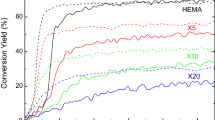Abstract
Use of organosilanes as hybrid systems is of increasing importance for their promising applications in the optical field. Considerable attention has been paid to the study of the inorganic network. However, poor information concerning the organic part involved in the solgel process is available. This is yet a fundamental requirement for optical applications where homogeneity at molecular scale is essential. Taking into account the specificity of the sol-gel medium, characteristics of the organic part have to be adapted with the view of optimizing the properties of the final material. Hybrid material used in this study consisted of organosilane precursor with methacrylate functions, titanium isoproxide, methacrylic acid and photoinitiator. The polycondensation of the inorganic component was achieved sequentially and simultaneously with the photopolymerization of the organic one to provide a mutually interpenetrating network. Polymerization in the UV range presents the advantages of fast-curing at temperature compatible with fragile substrates and spatio-temporal selectivity of the reaction. Characteristics of the photopolymerization process taking place in hybrid sol-gel materials were investigated by UV and Real Time FTIR spectroscopy. Besides the study of the organic network, NMR investigations led information relative to the inorganic network formation during the sol maturation. The whole results provide insights into the optimization of the photochemical step. Indeed, it was demonstrated that titanium components added as passive components to increase the refractive index of the layer, can induce polymerization under a medium pressure mercury arc lamp irradiation. In addition, mix photoactive systems involving an organic photoinitiator and titanium components were investigated and led to a better efficiency for the photoinitiation. Final materials with higher conversion ratio of the methacrylate function and requiring shorter irradiation times were achieved.
Similar content being viewed by others
References
C. Sanchez Matériaux Hybrides, (Masson Paris, 1997), p.27
D. R. Ulhmann, G. Toewee, J. Boulton, J. Sol-Gel Sci. Technol., 8, 1083 (1997)
O. Soppera, C. Croutxé-Barghorn, C. Carré, D. Blanc, Appl. Surf. Sci., 7346, 1 (2001).
F. Babonneau J. Maquet Polyhedron, 19, 315 (2000).
O. Soppera C. Croutxé-Barghorn, D. J. Lougnot New J. Chem., 25, 1006 (2001).
J. P. Fouassier J. F. Rabek Radiation Curing in Polymer Science and Technology. Fundamentals and Methods, (Elsevier Applied Science London, 1993), vol 1-4.
O. Soppera C. Croutxé-Barghorn, Entropie, 235–236, 20 (2002).
O. Soppera C. Croutxé-Barghorn, submitted to Chemical Physics, Oct. 2001.
E. Andrzejewska Prog. Polym. Sci., 26, 605 (2001).
Author information
Authors and Affiliations
Rights and permissions
About this article
Cite this article
Soppera, O., Croutxé-Barghorn, C. & Carré, C. Optimization of radical photopolymerization in hybrid sol-gel glasses: advantages of bicomponent photoactive systems. MRS Online Proceedings Library 726, 911 (2002). https://doi.org/10.1557/PROC-726-Q9.11
Published:
DOI: https://doi.org/10.1557/PROC-726-Q9.11



